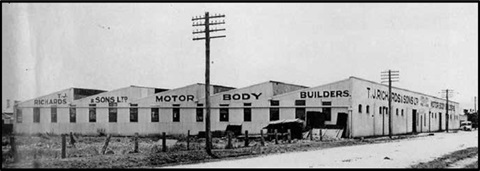Richards / Chrysler (Mile End South)

Tobias John Martin Richards (3 February 1850-29 July 1939) was born at Montacute, South Australia, the eldest son of sixteen children of Cornish Wesleyan Methodists John Martin Richards (1824-1867), clerk, miner and teacher and his wife Catherine (née Reed) (1823-1908).
By 1881 Tobias was working in suburban Unley North as a blacksmith and coach hardware maker and fitter. It was at this time that he began learning the craft of coachbuilding from Ludwig Maraun of Pirie Street.
Richards was by then a highly respected coachbuilder, winning many awards at national and state shows and producing over thirty designs of coaches and sulkies. His most famous design was the ‘King of the Road’ coach.
In September 1907 Richards extended his Hindmarsh Square business to two storeys and 0.46 acres/c. 0.19 hectares. The West Mitcham business was closed in early 1909 and production and sales were concentrated at Hindmarsh Square.
Richards retired in April 1911 and the business was renamed as T.J. Richards and Sons, with authorised capital of £25,000. Richards’s second and third sons, Henry (1878-1915) and Claude (1882-1950) jointly took over the running of the company.
As Richards’s business grew the need for more factory space became clear. In February 1920 the company bought a 3.16 acre/c.1.28 hectare site at the northern corner of the Bay Road (from 1924 Anzac Highway) and Leader Street, Forestville for £1,900.
Although the plant subsequently built on the site was in Forestville it was invariably referred to as being located in Keswick, probably because it was directly south of the Keswick Army Barracks. Later extensions to the factory were technically in Goodwood West and Horncastle.
The plant eventually expanded to 8.53 acres/c.3.45 hectares; for many years a huge ‘Chrysler-Dodge-Plymouth-DeSoto’ Art-Deco neon sign fronted the business at the corner of Anzac Highway and Leader Street.